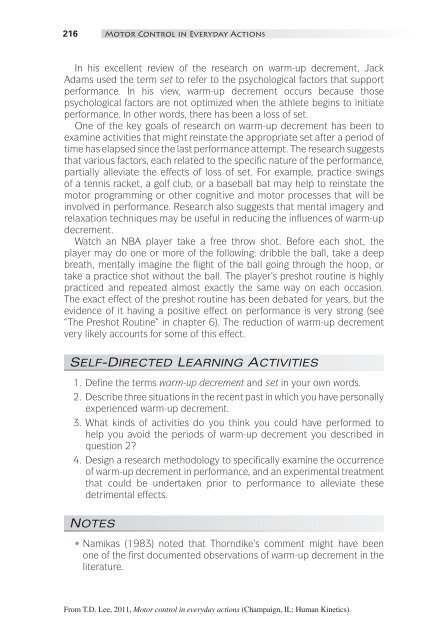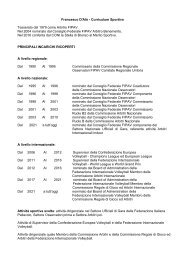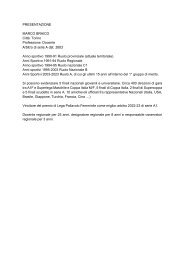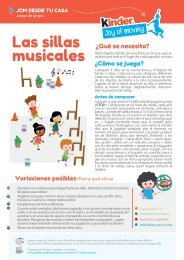Shooting Two From the Line
Create successful ePaper yourself
Turn your PDF publications into a flip-book with our unique Google optimized e-Paper software.
216 Motor Control in Everyday Actions<br />
In his excellent review of <strong>the</strong> research on warm-up decrement, Jack<br />
Adams used <strong>the</strong> term set to refer to <strong>the</strong> psychological factors that support<br />
performance. In his view, warm-up decrement occurs because those<br />
psychological factors are not optimized when <strong>the</strong> athlete begins to initiate<br />
performance. In o<strong>the</strong>r words, <strong>the</strong>re has been a loss of set.<br />
One of <strong>the</strong> key goals of research on warm-up decrement has been to<br />
examine activities that might reinstate <strong>the</strong> appropriate set after a period of<br />
time has elapsed since <strong>the</strong> last performance attempt. The research suggests<br />
that various factors, each related to <strong>the</strong> specific nature of <strong>the</strong> performance,<br />
partially alleviate <strong>the</strong> effects of loss of set. For example, practice swings<br />
of a tennis racket, a golf club, or a baseball bat may help to reinstate <strong>the</strong><br />
motor programming or o<strong>the</strong>r cognitive and motor processes that will be<br />
involved in performance. Research also suggests that mental imagery and<br />
relaxation techniques may be useful in reducing <strong>the</strong> influences of warm-up<br />
decrement.<br />
Watch an NBA player take a free throw shot. Before each shot, <strong>the</strong><br />
player may do one or more of <strong>the</strong> following: dribble <strong>the</strong> ball, take a deep<br />
breath, mentally imagine <strong>the</strong> flight of <strong>the</strong> ball going through <strong>the</strong> hoop, or<br />
take a practice shot without <strong>the</strong> ball. The player’s preshot routine is highly<br />
practiced and repeated almost exactly <strong>the</strong> same way on each occasion.<br />
The exact effect of <strong>the</strong> preshot routine has been debated for years, but <strong>the</strong><br />
evidence of it having a positive effect on performance is very strong (see<br />
“The Preshot Routine” in chapter 6). The reduction of warm-up decrement<br />
very likely accounts for some of this effect.<br />
Self-Directed Learning Activities<br />
1. Define <strong>the</strong> terms warm-up decrement and set in your own words.<br />
2. Describe three situations in <strong>the</strong> recent past in which you have personally<br />
experienced warm-up decrement.<br />
3. What kinds of activities do you think you could have performed to<br />
help you avoid <strong>the</strong> periods of warm-up decrement you described in<br />
question 2?<br />
4. Design a research methodology to specifically examine <strong>the</strong> occurrence<br />
of warm-up decrement in performance, and an experimental treatment<br />
that could be undertaken prior to performance to alleviate <strong>the</strong>se<br />
detrimental effects.<br />
Notes<br />
• Namikas (1983) noted that Thorndike’s comment might have been<br />
one of <strong>the</strong> first documented observations of warm-up decrement in <strong>the</strong><br />
literature.<br />
<strong>From</strong> T.D. Lee, 2011, Motor control in everyday actions (Champaign, IL: Human Kinetics).

















